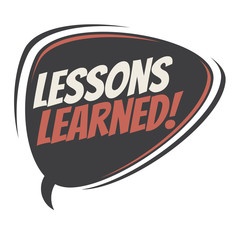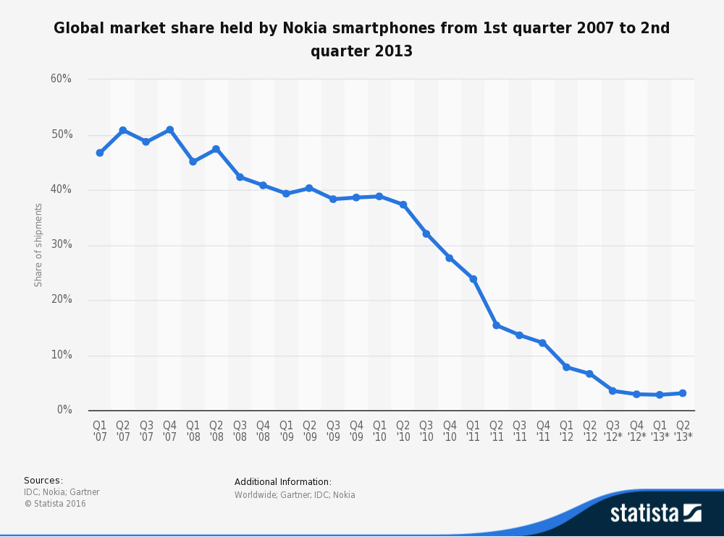As we come to the end of 2016 and start the business planning process for 2017 and beyond,  business leaders around the world are going through a multitude of a strategic planning meetings where they are assessing where there are now, where are they going, and how they are they going to get there. Reviewing learnings from other successful and not-so-successful organizations should be part of every business planning review process. There are many organizations feeling strong and secure in their market positions and this blog is written for you with a warning; don’t get too secure! For organizations that currently maintain strong market positions, there are very good business lessons to be learned from the fall of Nokia’s smartphone marketplace dominance. As the graphic below illustrates in the second quarter of 2007, Nokia owned more than 50% of the global market share of smartphones. Today, it is a number that is hard to comprehend. By the end of the second quarter of 2013 - just 6 years later - Nokia’s market share declined to almost zero. It is shocking data which should be recognized and absorbed by business leaders so they can avoid the same mistakes Nokia did.
business leaders around the world are going through a multitude of a strategic planning meetings where they are assessing where there are now, where are they going, and how they are they going to get there. Reviewing learnings from other successful and not-so-successful organizations should be part of every business planning review process. There are many organizations feeling strong and secure in their market positions and this blog is written for you with a warning; don’t get too secure! For organizations that currently maintain strong market positions, there are very good business lessons to be learned from the fall of Nokia’s smartphone marketplace dominance. As the graphic below illustrates in the second quarter of 2007, Nokia owned more than 50% of the global market share of smartphones. Today, it is a number that is hard to comprehend. By the end of the second quarter of 2013 - just 6 years later - Nokia’s market share declined to almost zero. It is shocking data which should be recognized and absorbed by business leaders so they can avoid the same mistakes Nokia did.

General Strategic Issues
The strategic advantages that you have created in your business today will be replaced by new innovations AND lower costs being delivered by your competitors very quickly by tomorrow. Recognize that you won’t do anything “wrong”; your competitors will simply catch up and do things better and different than you. Your strategic goal is to learn, improve, and deliver the right value proposition to the right customers.
Business Lessons Learned from the Nokia:
Spent money on R&D but not on products people wanted
Like many innovative organizations executing a product leadership strategy, Nokia continued to invest in R&D. Unlike Kodak who invented digital photography but made a conscious decision NOT to sell it for fear of cannibalizing their camera, paper, and film businesses, Nokia continued to invest in new technologies such as touch screens and internet enabled phones years before their competitors like Apple and Samsung. The problem was that they were unable to invent technologies that worked well and that people wanted to buy. Nokia had a very proud engineering driven culture and it turns out that the engineers were developing “interesting” technologies that weren’t feasible or well matched to the specific needs of customers.
Learning Point: Make sure you are investing R&D in products and services that your customers want and need (and aren’t cool to invent).
Lack of Marketing Savvy
Because of the strong engineering focus and culture, the organization lacked strong marketing savvy. In organizations with this similar culture too often the R&D leaders start believing that the products will sell themselves and there is no need for investing in marketing and sales. Based on the success of companies like Apple, Coca-Cola, P&G, and other powerful brands we can determine that marketing awareness is a critical catalyst for making sure the perception of product genius is greater than the technology of the product itself.
Learning Point: No matter how great you think your innovation and technology is, you still have to create market awareness and sell it. Great products really don’t sell themselves!
Software and the creation of an ecosystem
The genius of Apple wasn’t in creating and innovating iPod and the iPhone, it was in creating a business ecosystem around them based on software, music, movies, and an infinite world of applications and information. iTunes makes more money for Apple then the sale of products, and Apple’s cut on the sales of apps from the apps store is even more than that! Nokia never saw this or imagined this world of adjacent markets and at the end of the day, this was the single biggest mistake that led to their downfall.
Learning Point: Even with innovation as a lead, continue to push and drive it further. Look to expand the adjacent markets to create an ecosystem that can grow even bigger and stronger.




